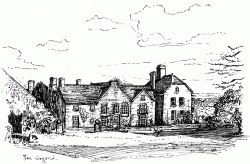
There was a great deal of destruction in the area between 1402 and 1409 during the rebellion of Owen Glendower, who won a signal victory just outside the parish boundary in 1404, at the battle of Craig-y-Dorth. Few houses now standing in Gwent date from before that time. The largest house in Penallt is The Argoed, built by Christopher Probert around 1580. The land was held in the reign of Henry VIII (with a good deal of other local property outside the Parish) by Thomas Probert, whose descendants still own property locally, and whose grandson William conducted a running battle in the Star Chamber with the Earl of Pembroke over the Master Forestership in ‘Wieswood’.
The original 16th century house was enlarged and partly rebuilt in the 17th and 18th centuries. It remained the property of the Proberts and their connections, Morgans and Cliffords, until the mid 19th century, but from about 1800 they ceased to live there and let it as a farm, when it fell into disrepair. Eventually, about 1860, Col Henry Morgan Clifford sold it to Richard Potter, who rebuilt the south wing and improved the rest. He was the father of Beatrice Webb (wife of Sidney Webb), and many of the early Fabian Socialists, including Bernard Shaw, were visitors there. In 1897 it was sold to the Chatfields, and fifty years later it came back into the possession of the Proberts, when it was bought by Major Y R H Probert. It has since gone through several hands, and is now divided into two separate dwellings.
Two other houses are The Glyn Farm, largely from the 17th century, but containing some 15th century stonework, and Llananant Farm which was built in the 16th century, the roof structure dating from 1580. Another of interest, though not ancient, is Moorcroft, built by Wiliam Bagnall-Oakley, curate of Penallt 1848-71. It was bought in 1885 by H L Pelham of the cricketing family, whose name is perpetuated in the Pelham Hall, built in 1928 as a Village Hall and replaced in 1992 by a new building which also houses the cricket and tennis clubs.